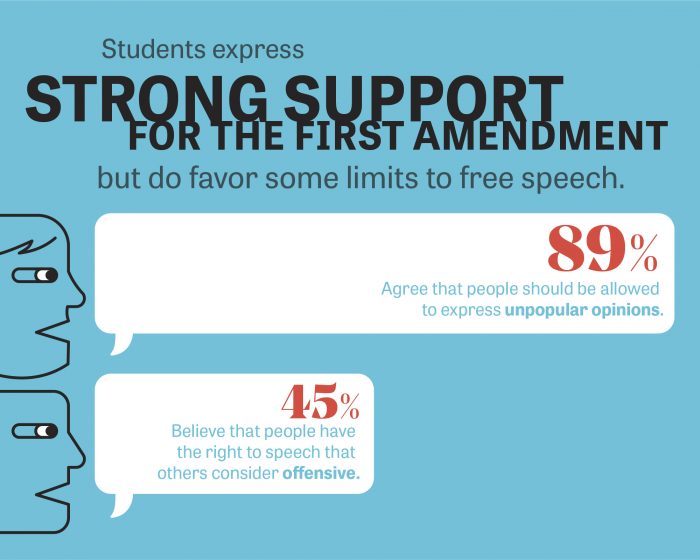
Have we lost the teachers but kept the high schoolers (for now)? It’s a tie.
49 percent of high school students and 51 percent of their teachers say they don’t trust the media to accurately and fairly report news, a Knight survey out today found, though the sample sizes are a bit warped (nearly 10,000 students vs. 500 teachers). This backs up similar findings with college students earlier this year.
But — potential silver lining alert — the teens overwhelmingly (89 percent) agree that people should be able to express unpopular opinions. 65 percent of students said protecting free speech is more important than protecting people from offensive speech. That’s good news for a generation some people seem to consider the most snowflakey and silo-chambered, following only the flop accounts that reinforce their own beliefs.
Over half of the teen respondents here, though, did say that social media can limit expression when users block those with opposing views and are less likely to share their views because of possible online dialogue dustups. 59 percent of the students say they use a messaging app as a news source, which has been a trend of more information and conversation happening out of the main feed.

The Knight researchers point out that most students are fairly united in their opposition to censorship compared to past studies. But the numbers are decreasing slightly: “About 6 in 10 students believe print and online newspapers should be allowed to publish any story without government censorship. This support has declined by 2 points since 2016. Similarly, more students say journalism ‘keep[s] leaders from doing things that shouldn’t be done’ (72 percent) than say ‘keeps leaders from doing their job’ (28 percent) when asked to choose, but in 2016 the split was 79 to 21 percent.”
“High school students continue to show strong support for First Amendment freedoms, but they don’t trust all of the expression it protects,” Sam Gill, Knight’s vice president for communities and impact, said in announcing the survey’s findings. “They are increasingly skeptical of the ability of news media to report fairly and accurately. This is a wake-up call from an emerging generation.” (Disclosure: Knight has funded Nieman Lab in the past.)

With the tragic demise of local newspapers, places like Mic have become the entry point into the craft for a lot of young journalists. What’s more, their newsrooms have been admirably diverse, a diversity that their journalism has admirably reflected.
As they go under, such entry points disappear. And the journalists who have been through this ugly process — sometimes more than once — burn out.
“They are taking the brunt of this,” [the Post’s ad tech director Aram Zucker-Scharff said, “and it’s psychologically damaging.”
The high schoolers in this Knight survey might be a diploma or two short of entering the workforce, but is there a trickle-down of this turnover to this media’s consumers, not just the producers? (Anecdotally, friends expressed their frustration to me over DNAInfo’s ripped-out-from-under-them-rug last year.)
In general, Americans are skeptical of the accuracy of news on social media, according to Pew data from September. But 40 percent of teen respondents to this Knight survey actually trust content posted by people more than that posted by traditional news organizations, compared to 26 percent who said the same in 2016.
A majority of the 3,000+ college students surveyed earlier this year said freedom of speech and of the press is secure, though both those numbers dropped from 2016 data: 73 percent —> 64 percent and 81 percent —> 60 percent, respectively. They, like these high schoolers, also said campus climate tensions have prevented people from speaking their minds at risk of being offensive or taken the wrong way.
My colleague Laura Hazard Owen shared college students’ direct thoughts about the media from a survey in the fall. In light of these high schoolers’ responses, they’re worth revisiting:I spend more time trying to find an unbiased site than I do reading the news I find.
It is really hard to know what is real in today’s society; there are a lot of news sources and it is difficult to trust any of them.
The fact that people consider news on social media as news is the most troubling fact, I mean nine times out of ten, a headline is only designed for ‘clickbait’ for ad revenue — I don’t use or trust news on social media.
Professors often believe that news that comes from print sources or large media outlets tend to be more reliable. While this may have been true previously, there are some lesser known or smaller creators, like those on YouTube or vigilant “civilians,” that have quickly become either more reliable or diverse in their reporting, and these sources should be considered more seriously in course assignments, though it should be asked, by professors, that students think critically about the source and try to use multiple sources from any platform.
Their end goal is selling advertising.
The full Knight report on the high schoolers’ media attitudes is here.